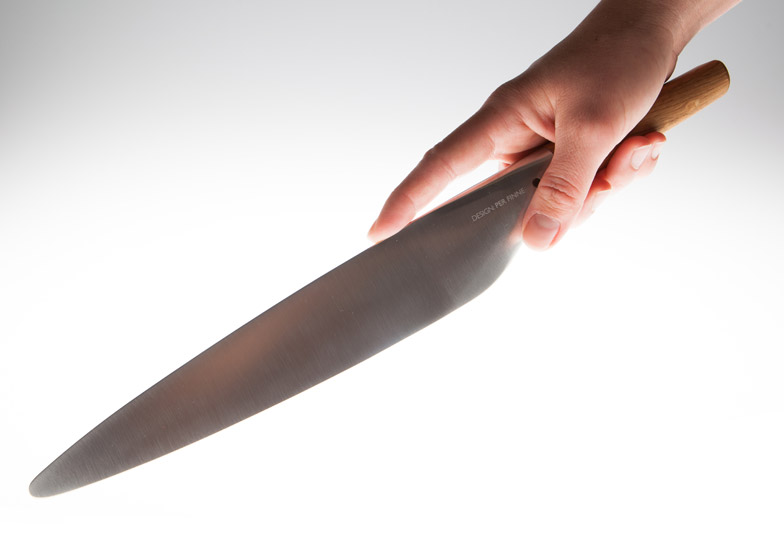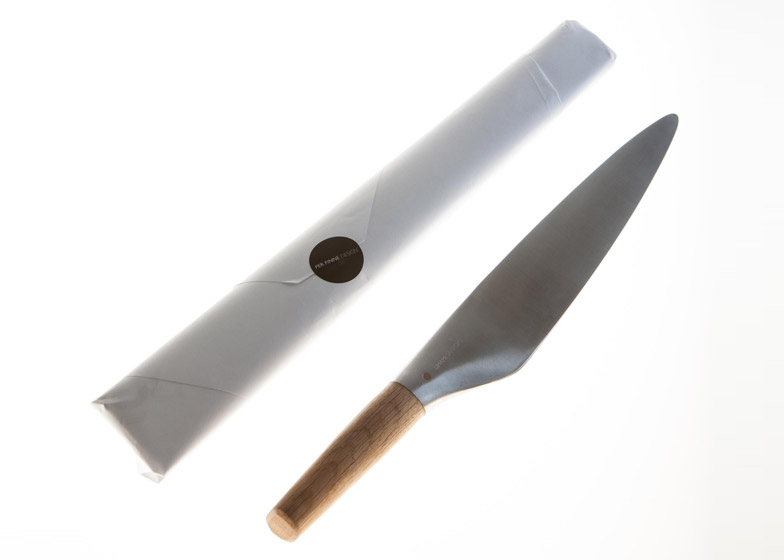Norwegian designer Per Finne has created a utensil based on traditional Japanese knives that he says offers enough flexibility to be the only knife needed in a home cook's kitchen (+ slideshow).
Per Finne's Umami Santoku knife aims to combine Japanese design traditions with a contemporary Norwegian aesthetic, and features a steel blade that curves at the base to meet a rounded oak grip with a smooth seam.
"I wanted to make a functional knife with a flexibility when it comes to different ways of gripping," Finne told Dezeen. "Erasing the transition between the handle gives a wider range of gripping possibilities – and the knife becomes an extension of the arm."
The name of the utensil is a combination of umami – a savoury flavour often referred to as the "fifth taste" that is crucial in Japanese cooking – and the name of a traditional multipurpose Japanese knife called a Santoku.
On a Santoku knife, the spine of the flat-edged blade that runs along the blunt side usually curves down towards the tip. The blade's width and weight is matched to the handle, creating a balanced utensil suitable for slicing, dicing and mincing. It differs from many Western-style knives as it is designed for cutting straight down, rather than using a rocking motion, and has a shorter, thinner blade.
The Umami Santoku knife uses the same principle of balance, but with shapes and materials more common in Norwegian design.
Finne said the idea that a "good knife is for life" was prevalent in Japan, but also resonated with Norwegian culture.
"In Norway, if we go back a few generations, it was just as important to respect utensils and tools, so they were cared for and would last a lifetime," said Finne. "I have experienced that people spend a lot of money on dull knives, when all they actually need is one good knife."
"The driving idea is that we can participate in care of the environment if we reduce the number of products we surround ourselves with, and if we treasure the tools we have," he added.
The steel of the blade continues into the handle, encased in the oak grip. The two pieces of the knife are joined by a small wooden peg, which is a reference to the single bamboo peg – called a mekugi – that is used to hold Japanese swords together.
Finne chose molybdenum-vanadium steel for the blade due to its ability to stay sharp, as well as its hardness, flexibility and durability.
"The oak handle was selected both to make a good contrast to the steel – and because it gives a good tactile experience," he said. "When it comes to hand tools, I think tactile aesthetics are just as important as the visual aesthetics."
Finne's previous designs include kitchenware and cutlery for Swedish firm HardangerBestikk, snowboarding equipment and bags for a variety of clients, and a safety harness for the Tripp Trapp adjustable highchair by Norwegian brand Stokke.
The designer has launched the Umami Santoku himself and it can be purchased directly through him, but will go on sale in a small number of shops later this year. The knife is being manufactured in Asia in a limited run of 500 pieces.





